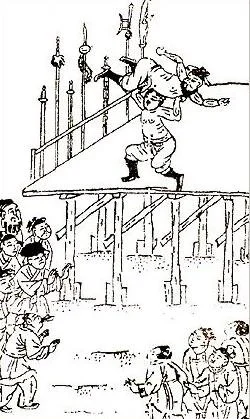長 拳
Cháng Quán
Long Fist
踢
Tī
Kick
摔
Shuāi
Throw
打
Dǎ
Strike
拿
Ná
Catch
拳術 Quánshù means boxing, but consists of 踢 Ti “kicking”, 打 Da “striking”, 摔 Shuai “throwing” (wrestling) and 拿 Na “seizing” (catch, joints locks). People would 下功夫 xià gōngfū or “put in the hard work” to gain these fighting skills. This consisted of kicking and punching to incapacitate or close the gap, bridging and control of the arms for dominance was made instinctive, and short strikes, locks and joint breaks, and throws and sweeps were used to destroy the opponent. Given the ‘common vernacular’ of northern Chinese boxing skills, and the fluid nature of learning, many styles arose - essentially, mixed martial arts. These were versatile combat methods, meant to allow one to duel a challenger, defend oneself against attackers, or eliminate threats swiftly. By the end of the Qing dynasty civilian fighting arts reached a high point in effectiveness.
For northern Chinese boxing systems, this often involved a 長拳 Cháng quán “Long Fist” or “Long Boxing” approach to commanding the distance and pummeling the enemy. Striking methods were blended with throws, sweeps, and takedowns. Since its methods were so widespread in China and were a core part of, or influenced, many Boxing systems, those interested in Traditional Chinese Boxing should learn the basics of 長拳 Cháng quán.
The Traditional Chinese Martial Arts (武術 Wǔshù) come from a context of a violent Confucian culture plunged into societal collapse. The late Qing dynasty was a turbulent time, with famines and floods, opium epidemic and foreign encroachment, mass banditry and open revolts. Many learned weapon skills as well as Chinese boxing and found employment as militia trainers, guards, and caravan escorts - or resorted to banditry.











長拳 Cháng quán
Long Boxing or Long Fist is an umbrella term for a whole ‘language' of combat movement’ from the North China plain. Most of the Chinese Boxing systems and styles are or have influences from Long Boxing. There are deep commonalities in most of these methods both technically and tactically.
基本長拳
Essential Long Boxing
If we look at fighting and movement as language, then there are many languages, with many dialects, accents, and personal flairs. China’s traditional bare knuckle boxings likewise was an expansive language family. Most seem to be in decline. If this powerful meta, this way of moving and fighting, is to be re-established, that baseline fluency in the combat movement-language must be attained… I have distilled and dissected 長拳 Cháng quán, Long fist or long boxing, and broken down its combat language for you so you can use these building blocks to become fully fluent.
Gain fundamental Chinese Boxing skills
This online course is designed to give you a high level overview on the core mechanics and strategic doctrine of the 長拳 Cháng quán (Long Boxing or Long Fist) art, and details on some of the most common techniques. This is not an encyclopedia of techniques nor 套路 Taolu or forms / sequences. This isn’t athletic training, nor is it fight coaching. I offer such things, but not here. In this course I give you a framework to understand, train, and practice Chinese boxing, whether you plan on taking up a system, or you have already devoted time into training an art.

